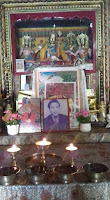HAIL
MOUNT HERMON!
“The woods are lovely, dark and
deep, But I have promises to keep...”
By Jigme
N.Kazi
In the two years from now, MH will celebrate
its 100th birth anniversary on March 11, 1995. Hermonites all over
the world, particularly in India and the neighbouring areas, are making
preparations to make the centenary year a grand success. This has led to the
setting up of the All Indian Hermonites Association (AIHA) with its
headquarters in Darjeeling. Pratap Singh Rai (MH 1964-68), who is in-charge of
the Association’s activities in this field, have been very active in his work.
The ex-students in Siliguri have recently formed The Foothills Hermonites with
Jagdish Singh (MH 1962-1971) becoming one of the most active members. The Mount
Hermon Alumni Association Nepal (MHAAN) of Nepal led by Tom Creese (MH
1955-63), Sulee Hung (MH 1962-1970) and Annie (Gardner) Vaidya (MH 1968-1979)
is also quite active and will definitely participate in the centenary celebrations.
The occasion will give us an opportunity to
focus our attention on the school, which needs help and guidance in various
fields. Its problems and prospects will have to be studies in depth and a
concrete plan of action has to be initiated by all Hermonites, friends and
well-wishers of the school to take our
dear old MH into the 21st
century and beyond.
We live and die, but life must go on. The ideals and values
and the high standards set by the school must continue to enrich our lives and
the lives of those around us. March 11, 1995 will indeed be an occasion for us
when we can, once more, join our hands and hearts together, and sing the school
hymn in full-throated voice and mean it:
“Beloved Mount Hermon, we greet thee,
Thy daughters and sons from afar
As of as we pause in our toiling
To hail thee whose children we are.
Hail, Mount Hermon! Hail, Mount Hermon!
Safe for aye in memory's shrine.
Hail, Mount Hermon! Dear Mount Hermon!
Praise and love be ever thine.
I loved MH and wanted to stay back, but
something in me pulled forward and I had to finally move out. And as 1979
approached, I knew it would be my last year in MH. By then I had made up my
mind to leave the teaching profession. MH had given me so much and the only way
to show my gratitude was to give myself for the school for a few years.
My attitude to life has always been to give
my best to whatever work in undertake. I certainly would not be able to do this
if I did not enjoy what I was doing. I realised that I would not enjoy being in
the teaching profession if I was not working in MH. It was partly because of
this that I opted for another profession and decided to go for law studies.
My attitude to life is best described in
these words from my little quotation book, which I have kept with me since
1967-68: “Behold, I do not give lectures or little charity; when I give, I give
myself”. I gave myself to MH fully and completely.
And as I look back now, I think the most
valuable and the lasting thing that I have learnt from MH was not in the classroom,
but on the playground; not from my textbooks, but from people and from everyday
experiences. Taking part in the various school activities, leading various
teams and finally the 1st XI football team and going through our
many defeats and victories on the playing field, have been some of the greatest
moments of my life. Giving my best shot and fighting till the very end,
irrespective of consequences, is what I have learnt from MH. And as I look back
over these fourteen years away from the old and familiar surroundings, I know
that whatever MH taught me during my brief sojourn in Darjeeling has withstood
the test of time.

In the final talk to the school on November
25, 1979, I said, “I venture into new frontiers with good intentions, high
ideals and faith in God. To those who will be leaving us at the end of this
year, let me urge you to give your life to a great cause. The kind of person we
are in tea years time will reflect what we have learnt here in MH. I will you
all the very best.”
And with tears in my eyes and a lump in my
throat, I gave my last few words to the school, which had been my home for
sixteen short years: “Sometimes when you reach out for a dream, you have to
leave something behind. I leave behind my school, my friends, my home...my MH.
The woods are lovely, dark and deep,
But I have promises to keep,
And miles to go before I sleep,
And miles to go before I sleep.
I
left MH at the end of 1979; but a part of me has always remained behind. And, I
guess, a part of MH has always been with me. Hail Mount Hermon!
(Ref:
Inside Sikkim: Against The Tide, Jigme
N. Kazi, published by Hill Media Publications, Gangtok, 1993)




















